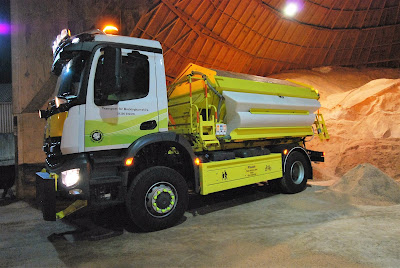The cold weather has started settling in, and our gritters went out for the first time at the end of October. Here are some answers to frequently asked questions that crop up every year when we begin our winter service...
Can you refill my salt bin?
Salt bins are stocked at the beginning of every winter, and then restocked
depending on demand and weather conditions. You can report empty salt bins
using Fix My Street – pinpoint the location and select ‘salt bin refill’ from
the drop down menu. We can’t fill bins immediately in response to each report,
but bins reported empty will be added to the list for the next cycle of
top-ups. There are over 1,200 salt bins across Buckinghamshire which
TfB are responsible for; each bin holds about half a tonne of rock salt, the
same stuff used on the roads.
My road doesn’t have a salt bin – can you provide one?
We can sell salt bins to private organisations with links to Bucks County Council, such as social care properties or schools. We will consider requests for new salt bins at known trouble spots on the public highway, however funding for new salt bins will need to be provided externally. We will consider requests from private organisations to buy salt bins as well; requests can be made using the contact forms on our website.Do new salt bins cost anything?
Initial setup costs are £475 per salt bin but once they are installed we will have no future liability for them, though it may be possible for us to refill private bins at a cost. For new estate roads all new salt bin requirements will be assessed, and the developer would fund the cost of the new salt bin and salt.Why don’t you grit my road?
Our primary salting routes cover the most important roads to keep everyone moving, covering 1405km of the county's A and B road network – that’s about 44% of the total network, and is more than many local authorities grit. In times of very severe weather salting will be carried out on secondary routes as well. These generally include classified roads which are not included in the primary routes, unclassified roads serving communities of 200 dwellings or more and unclassified roads with a gradient of 10% or less. In general, the secondary salting network will be treated in the event of severe ice or snow.Why are you gritting, it’s not even cold?!
Our first gritting run this year was really early, 26th October (there was a lot of excitement in the office at this surprising news) and several people questioned why we were salting when the forecast wasn’t that cold. The simple answer is; because road surface temperature is often several degrees lower than air temperature. We have a tried and tested system for making the gritting decision during winter – our dedicated winter team receives a detailed weather forecast analysis every day, which contains information on air temperature, road surface temperature, likelihood of snow and ice, humidity and wind speed. Using the data they are given, the team decides whether or not to salt the roads, and at what time.…But are you saving some salt for when it’s really cold?
Yes. We have four rock salt barns based across Buckinghamshire in High Wycombe, Amersham, Aylesbury and Buckingham, as well as an emergency reserve of 3000 tonnes of salt near south Bucks, just in case. Each barn holds around 2,000 tonnes of salt at a time and is topped up throughout the winter. Last year, despite three major snow falls (a rarity for Buckinghamshire) we did not run out of salt. |
| The salt barn at Handy Cross depot |
What the heck is a hoar frost?
We will quite often mention if a hoar frost is forecast in our daily gritting updates – a hoar frost is, put simply, a very thick and fibrous looking frost. A lovely fact, courtesy of the Woodland Trust is that hoar ‘comes from old English and refers to the old age appearance of the frost: the way the ice crystals form makes it look like white hair or a beard.’
Hoar frost occurs in much the same
way as dew with moisture in the air condensing onto a surface. When the surface
(i.e. the road temperature) is below zero, regardless of air temperature, the
moisture will condense as ice rather than water – this is a hoar frost. Thus,
although conditions may appear perfectly dry, ice can form on cold untreated surfaces.
 |
| Hoar frost |
Do you name your gritters like other counties do?
Yes – our gritters are called: Walter the Salter, Salt Disney, Usain Salt, Snow Farah, Grit ‘n’ bear it, Grit Expectations, Gritty Bang Bang, Ice Ice Baby, Snowbot, Rocky Horror, The Gritter Good, True Grit, Betty, Dawn Raider, Salty Snowflake, Brrrrrrrian, Blizzard Wizard, and Snowphie. When they’re out and about you can track them, here.Can you call the next one Gritty McGritface?
No.
For more information on the council’s winter services, visit
buckscc.gov.uk/readyforwinter



